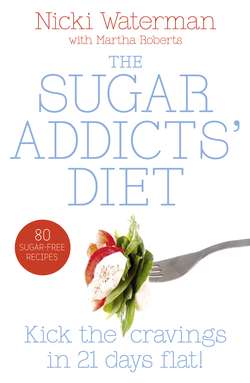Читать книгу Sugar Addicts’ Diet - Nicki Waterman - Страница 25
THE SUGAR ‘ROLLER COASTER’
ОглавлениеWhen we eat simple or ‘sneaky’ sugars, they go straight into the blood. This huge ‘hit’ of sugar causes the body to flood the bloodstream with the sugar-control hormone, insulin, to try and regulate sugar levels. The trouble is that the body isn’t designed for such high sugar levels – the most sugar our caveman ancestors would have got was from berries picked off bushes, not chocolate bars or jelly babies! Excessive amounts of insulin end up being released to deal with the sugar, either by removing it from the blood or taking it to the muscles.
Imagine a roller coaster which starts off at a low level, climbing to a high peak before dropping down into a dip. It’s the same principle when you eat sugar. You start off with low amounts of sugar in the blood (the roller coaster dips), eat lots of sugar (the roller coaster rises), then insulin is produced to flush the excess sugar out, dropping sugar levels back down (the roller coaster dips again).
‘So what?’ you might think. Well, eating sugar – where the roller coaster peaks – and the rise in blood-sugar levels may make you feel high, happy and even euphoric. After all, that’s one of the reasons sugar is so attractive. But the point at which the roller coaster falls – the ‘sugar dip’ – can leave you feeling tired, ratty and even depressed. As well as increasing your risk of certain illnesses (see Chapter 4) and putting on weight, it’s this dip that can make you want to eat more sugar to get that roller coaster back on a high again. If you don’t break your sugar-eating habits, you’re essentially destined for life on a sugar roller coaster that you’re not allowed to get off. Life on this roller coaster is a crucial part of sugar addiction.
